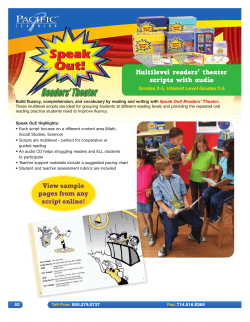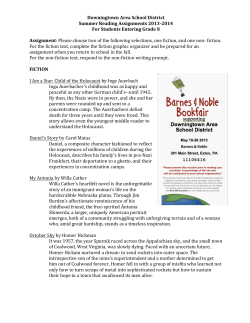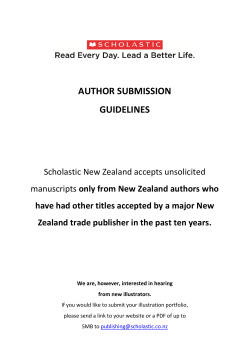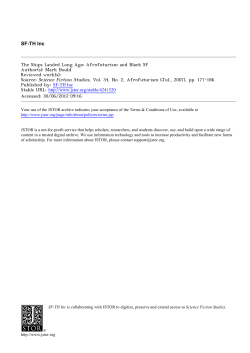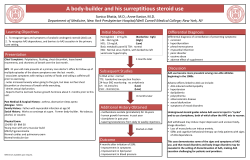
science fiction double feature
science fiction double feature science fiction double feature Published by aas publishing, 48 Oxford Road, Moseley, Birmingham. B13 9ER. All rights reserved. No part of this publication may be reproduced in any form without the written permission of the copyright holders. ISBN 0-9546405-0-0 Copyright for individual texts and images remains with the artists. Copyright for the rest of this publication © 2003 aas so we were thinking about science and fiction and science fiction, and figured it’d be a good way to thrash out a bunch of ideas we had and get some other people to join in too, of course this was a while ago and now we’ve driven ourselves mad with it all, but we love science fiction even though we know it’s escapist and perpetuates the status-quo by giving us something outside of the everyday that we desire and then when we’re addicted they sell it back to us, and we’re too blinded to think about how little revolution there actually is in the future, but still, it was watching and reading those things that pumped up our imaginations so that we believed we could make something happen, and the lower the budget and the more cobbled together the sets, the more you see what’s really important, that everything is as true as we want to make it, and that the future doesn’t exist, so it’s all about now, the most outrageous plots and aliens are no more fiction than any gritty drama or politicians speech, and science is fiction anyway, it splits everything up into manageable pieces and makes things seem valid by using a method, but art and literature use methods too and no-one thinks they always tell the truth, science is always changing what it tells us: the world is going to be wiped out by a masses, which is probably partially true, but as individuals they’re all as fucked up giant asteroid, no it’s alright we could destroy it in time, oh no we couldn’t, oh yes and self-obsessed as the rest of us, but we like to think there’s someone out there we could, some science accepts the uncertainty, the fuzziness of logic, but what’s fucking with our heads so that we don’t have to face the fact that we’re fucking always presented in the media is science as a solid, trustworthy authority, white with our own heads, that we want to believe the lies and that’s why they work, coat = believe, its all acting, and it spreads into fiction, people trust the opinions of even though we know it just makes us more likely to waste our lives and money actors who play doctors more than those who play killers, and have you noticed if we identify with this film, this computer game, this book, this comic, this album, how there’s all these programmes where it seems like they’re fiction but everyone this computer, this mobile phone, we still do it, we’re still wired to project ourselves talks like they’re real, as well as all the ones they admit are fakes, we’re all losing our outside our bodies into stuff, use a bone, use a phone, and it’s very easy to imagine boundaries between truth and fiction, which can be a good thing if you are aware that art is immune from all this and we don’t have to watch for the same stories of it, and make use of it, but sometimes it gets difficult and you find yourself caring here, but of course that’s just wishful thinking and we’re just as likely to idealise our more about who wins big brother than something really important like, like, see favourite artist as a rock star, believe that something is a good piece of art if we it’s getting difficult to say what’s important anymore, we’re getting our information see it in a respected gallery in london, or think an organisation is professional if they about the world through media which we know are flawed, so we doubt everything produce an orderly, attractive catalogue. and maybe that’s what they want, of course the idea of “they” is another fiction, this conspiracy theory that those in authority are plotting how best to manipulate the aas aas science, fiction and science fiction science because it makes things true fiction because it makes things false science fiction because it does both at the same time fabienne audéoud & john russell I stand on the lectern. You can see yourself in me. I am a model, abag* (a bag)* full of emptiness and germs. A wooden trunk; a wood piece. Nicely round, in the proportion of an erect penis, why not - I might as well but you don’t have to. When it’s finished it shrinks, it does it without doing it. Within analogies, it will do it. You thinking the wooden trunk go soft and I will fall inside the penis. I know it’s grammatically wrong but somehow it can’t be changed. A penis in wood in the gallery. Quite big, but not too big. And outside. Outside. Hell has come to earth. The cockroaches hunt in packs. THEY ARE QUICK. Their black silhouettes moving across the green countryside rounding up herds of sheep and humans and killing them. They move so quickly. The town is infested. Every now and then a human runs down the street. But not for long. Most of the rest of England must be infested. There is no traffic on the motorway and if you look off the cliff; the sea is black with them swimming to France and back. But maybe it’s Heaven. The sun reflects gold on a thousand carapaces. A world covered in angels. (extracts from ‘frozen tears’) Adam Baker Life is the name of the game And I wanna play the game with you Life can be terribly tame If you don’t play the game with two Yeah life is a go-as-you-please And I need some place to go with you Life can be oh-such-a-tease If you don’t play the game with two Remember life’s a gamble When choosing partners you should take good care To go on nature’s ramble And grab yourself a fair share Wo-oh there’s so much there Because the name of the game is life And you may find out some trouble and strife And you can end up taking all the blame Cos the name of the game is life Yeah the name of the game is life The name of the game is life! And I wanna play the game with you Dan Bass & Andrew Palmer The work we are exhibiting here in Birmingham is taken from a show that took place in August 2003 at the IOTA gallery in Ramsgate. “With the forth coming Turner Centre and about 20 other galleries popping up in Margate, the political and social atmosphere is reaching boiling point. This feeling brings to mind The classic sci-fi’ films of the 50’s these were primarily about ‘fear of the unknown’ in their case it was aliens from space, which was actually a thinly veiled metaphor for the rise of communism. What we wanted to achieve with the work is to try and capture the feeling of anticipation before the event. Placing Thanet into a narrative, a fictional story. The artists aim is to produce art from various different viewpoints with a mix of satire, irreverence and expressionism yet always with great fondness for the area. The problem in Thanet at present is the influx of quite challenging contemporary art, this being very popular within the artistic community, is however causing confusion and alienation amongst the populous of the area resulting in many angry letters in the local press regarding the forthcoming ‘Turner Centre’. The aim of our exhibition is to show that modern art can be ‘accessible’, understandable and most of all enjoyable.” The above is an extract from a press release prier to the opening of ‘Dial 01843 for supreme excitement beyond belief in 3D’. Ana Benlloch It’s not real, you can be as honest as you like. Tell me anything you like. There aren’t any consequences. I don’t exist. What you say won’t be heard, it’ll just become bits and vanish. It’s all fiction anyway, you can just tell yourself you didn’t mean it. No-one knows who you are: you’re free, invisible. You’re someone else, someone who doesn’t exist. Our connection is less than a glance, less than a breath. What reason is there to hide anything? You can tell the truth here. Simon Bloor Today your love, tomorrow the world “Progress and catastrophe are the opposite faces of the same coin.” - (Hannah Arendt) Tom Bloor • As for the story in Black Garterbelt magazine: Trout had no idea that it had been accepted for publication. It had been accepted years ago, apparently, for the date on the magazine was April, 1962. Trout found it by chance in a bin of tame old magazines near the front of the store. They were underpants magazines. When he bought the magazine, the cashier supposed Trout was drunk or feeble-minded. All he was getting, the cashier thought, was pictures of women in their underpants. Their legs were apart, all right, but they had on underpants, so they were certainly no competition for the wideopen beavers on sale in the back of the store. ‘I hope you enjoy it,’ said the cashier to Trout. He meant that he hoped Trout would find some pictures he could masturbate to, since that was the only point of all the books and magazines. ‘It’s for an arts festival’ said Trout. • As for the story itself, it was entitled ‘The Dancing Fool.’ Like so many Trout stories, it was about a tragic failure to communicate. Here was the plot: A flying saucer creature named Zog arrived on Earth to explain how wars could be prevented and how cancer could be cured. He brought the information from Margo, a planet where the natives conversed by means of farts and tap dancing. Zog landed at night in Connecticut. He had no sooner touched down than he saw a house on fire. He rushed into the house, farting and tap dancing, warning the people about the terrible danger they were in. The head of the house brained Zog with a golfclub. -Kurt Vonnegut, Breakfast of Champions David Brinkworth The Sci-Fi Research and Data Collecting Agency Giving the artist information from outside of time. The Sci-Fi Research and Data Collecting Agency would like to take this opportunity to state that it has been a pleasure to work along side The Fine Art Service Industry - Working for the viewer, the artist, and the institute. Arlene Burmett PHOTOGRAPHING THE ‘TRUTH’ ‘A good record should be properly exposed, processed and printed. It must be correctly focused and sharp throughout, and all vertical lines of the picture must be upright and should not converge on the print. Photographs should not be retouched, treated or marked in any way. Exaggerated lighting effects must not be used, and deep shadows or burnt-out highlights could reduce the value, as evidence, of an otherwise good record picture. Photographs should, where possible, be taken from eye level. In addition to understanding the scientific principles of physics, optics and chemistry on which photography depends, the photographer must have imagination and creative ability to reproduce scenes on film so that they convey to the viewer the same information and impressions he would have received had he directly observed the scene.’ H. Pountney, Police Photography, London 1971 (Former Detective Chief Inspector of Birmingham City Police) David Burrows For further information on alien abductions and visitations please see: p 78-81, ‘Walter Benjamins lost weekend’ in ‘The Dialectics of Seeing’, Susan Buck-Morss p 301-342 and dreams involving flying, cigar-shaped objects and one-eyed people ‘The interpretation of Dreams’, Sigmund Freud p 273-279 ‘A frightening message from beyond the stars’ in ‘Basic Writings: Martin Heidegger’ Edited by David Farrell Krell Clive Caswell Father, Son, and Obi Wan Star Wars dominated my childhood. The films, the models, and the dream that one day I would become a Jedi Knight and explore the far, far away galaxies. Dressing gowns became Jedi Robes and cardboard tubes with a little imagination, and felt tips, were transformed into lightsabres. I would sit and stare at objects, believing that if I focussed long and hard enough then the force with which I was undoubtedly blessed would cause them to move or even levitate. It never happened. I have a very short concentration span. Russell Chater Current work results from a fascination with ‘space’, distance and technology - as well as readings that oscillate between the familiar and the mysterious. My images of the insides of computer monitors reveal an ambiguous and evocative space existing beyond the screen. The viewer is placed as a voyeur to a space made distant and alien. Through simple experimentation with lenses, scale and lighting, the theatricality of this space is heightened. Inspired by their strange white shapes, my drawings and paintings of, and installations with, the polystyrene packaging one finds around technological equipment similarly attempt to increase the ‘other-worldly’ and seductive readings of the material - to reveal ‘alien’ craft and unfamiliar landscapes. In my prints of mirror boxes, the lens of the camera presents and records itself as a ‘void-like’ point - plotting and repeating through a gridded ‘infinite/vacuous’ space. The image is essentially created through its recording and this minimal intervention is characteristic of my working method. Re: Frank Cougar We live in a fearful world (WHY?) Picture a man with a mic on a stage (or, on a bus) asking a lot of questions and looking for a few answers, notes from a questioning mind. The whole Frank Cougar thing covers music, spoken word, character based studies of life all wrapped up in a blanket, hand woven by Bill hicks, Jim Morrison, John Millius. Hunter S. Thompson, Charles Bukowski, Jerimiah Johnson and Elvis; hopefully a lot of fun and maybe a touch of wisdom. Image courtesy of Capsule The universe is composed of an infinite number of frequencies. Some are macroscopically large and some microscopically small. All exist in uncountable phase relationships with one another. The colours of light, the sound of music, the smell of flowers, the touch of velvet, all are made of combined frequencies. Some are in phase and adding to, some are out of phase and cancel from. Our five senses are capable of interpreting these particular waves and making them tangible to our perception. Beyond these senses most of us have to rely on artificial means to convert these frequencies to the range of our comprehension. The Earth as most of us know it, is only a giant ball of rock, soil and water Covered with an atmosphere. We are unaware of the restless energy that surrounds us and which vibrates out of sight in the depths of the Earth, i.e. Earthquakes, Volcanoes, and above the earth with Thunderstorms and the Northern lights, All signals from natural events seething in a cauldron of frequencies, Also man made signals from communication and broadcast stations, experimental transmitters of many types are using the ionosphere to echo unseen messages. All of these signals have one thing in common they use the atmosphere and ionosphere above the surface of the Earth and the Earth itself beneath the surface to propagate and travel. Our aim is to collect these natural frequencies and make them audible, then combine them with man made frequencies over a back drop of 1930’s to 1950’s old science fiction radio broadcasts which are forever travelling out into the cosmos. John Rogers, Brian International and End Of Level Boss present BOSS Your life so far has been level one. Now you must face the end of level boss. http://www.endoflevelboss.cjb.net http://www.johnrogers.cjb.net http://www.brianhiroshima.cjb.net http://www.thefuckingshit.cjb.net E.T. E.T. is a group formed by two individual artists, Elena Kamma and Takayuki Yamamoto. Yamamoto explores the terrain of fairy tale realism to challenge what kind of life is possible in the world where fiction and non-fiction are at both times present and without division. Kamma has been working on ideas of accessibility, openness and closure. As a group, Kamma and Yamamoto explore the concept of being a human individual today, being open to any artistic medium. This work explores the expansion of the human individual’s consciousness 20 years after the Baudrillard’s theory on the Simulacrum. E.T. focuses on how global culture affects the formation of new structures of individuality and therefore communication, questioning at the same time the ideas of new and old. For the animation we have used analogue techniques, such as pencils and notebook and digital technique, such as DVD camera and computer. S Mark Gubb I’ll never forget the day I bought that record. I’d been up for three days straight, partying with an endless stream of girls, shooting speedballs and freebasing coke. I’d lost all concept of time and place but our tour manager had managed to track me down to get me to sound check, somewhere in Nottingham I think. On the way to the venue I spotted a second hand record store and insisted on going in. That’s where I found the record. I don’t know if it was the drugs or what but the record just seemed to strike a chord. The childish picture reminded of the little boy I once was, still am, and his insecurities. But it also reminded me of how I’d dreamed of reaching this point. I’d literally reached for the stars and touched the moon. A couple of weeks later the tour rolled up in southern Spain and we had a couple of days off. I decided to go and party with the surf crowd in Tarifa. Two sleepless days later and the ever increasing crowd I was with were on our way to another bar or to meet another dealer, I can’t remember, and we passed through a night market. On a stall there that picture caught my eye and I had to get it. The insecure little boy I was talking about had always loved colouring and I think, by this time, I knew that rehab was just round the corner again. It was like that little boy was warning me he was coming back to haunt me one more time. Mark Harris Summer 2003, London’s Victoria Park after closing time. Like Aragon’s Buttes-Chaumont, darkness exaggerates the artifice of the park. The marvellous, suffusing everyday experience, leaves the streets for the science-fiction set of fabricated nature. The night of our cities no longer resembles that howling of dogs of the Latin shadows, or the wheeling bat of the Middle Ages, or that image of sufferings which is the night of the Renaissance. She is a vast metal monster pierced by countless knives. Thus, in public gardens the densest part of the darkness is no longer distinguishable from a kind of desperate kiss exchanged between love and rebellion. Believing that rebellion has failed in the present, science-fiction’s mannerist hyperbole takes up the proposition of the marvellous from Surrealist poetics to secure the possibility of revolt in the future. The increasing rigidification of present political realities will dissolve under the science-fiction narratives that have been projected ahead of us. The caution of Benjamin’s to take responsibility for all images of the past as if they were our very own now concerns all images of the future. Sun Ra’s planet of psychedelic botanical gardens and cosmic jazz intensifies the intoxicated dreaming of Victoria Park at dusk. The music is different here, the vibrations are different. Not like planet Earth. Planet Earth’s sound of guns, anger, frustration. There was no one to talk to on planet Earth who could understand. We set up a colony for black people here. They could drink in the beauty of this planet. We’ll affect their vibrations, for the better of course. Reuben Henry a document “Allow me to introduce you to Ceti Alpha Five’s only remaining indigenous life form.” Marc Hulson “Marc Hulson’s paintings map a downbeat mindscape like stills from an oh!-so-sombre sci-fi movie. It’s eternally dusk on this planet drowned in deep orange and pink shadow where bleary eyes see in tinted monochrome. A consciousness clouded by thinking –the-worst goes walkabout here with brow well-furrowed on a lonely mezzanine between waking and sleeping, light and darkness, real and imaginary. Meanwhile something like rat’s tail or cat-gut repeatedly appears, provoking visceral responses to add to the stew of emotions Hulson stirs up with deceptively simple means.” (Paul O’Kane, CIRCA 89, Autumn 1999) Calum F Kerr The intertwining of horror and absurdity may be found in the crack between (supposed) reality and its fantastical alternative. A series of performances, installations and prints suggest alternative systems, embracing utopias while touching on their obsolescence. Found within urban landscapes, dilapidated (though seldom banal) material raises a challenge to corporate trends and ideal lifestyles. The curious object, created from abandoned materials may contain a pulsating heart (and character) beneath an apparently decrepit (and dumb) façade. These are developed through a fractured mythology gleaned from cult film, literature, science and top-shelf gardening magazines. After assembling the constructions they are activated through travelling ‘outside’, into the streets. These routes are trod by ‘Allen’, a (barely) human composite figure trying (and often failing) to negotiate situations in this newly realised world. These combined performances form rituals from the future while also relating to specific past/present systems. Allen is revealed inhabiting a place governed by cosmology, mutant relations and covert social networks. Suspicious growths, monstrous objects form a natural order defined through construction and genetic manipulation. These aspects collide to imply a disquieting future - a splintered reality. Peter Lloyd Lewis ELK SPACE 2000 The place - a forest in Canada. The event - an exhibition for Elk. Invigilation stations were created and we waited……… David Mabb Hubble Eight minutes 22 seconds. Music ‘fountainbridge’ from the CD ‘time on their hands’ by Rooney. The structure of the dvd is taken from a computer-generated movie/animation that replicates the zoom tool in the computer software programme Photoshop. The animation takes the viewer on a journey, starting with an image of the Hubble Space Observatory, which appears to move slowly towards the viewer. As it appears to get closer it breaks up into pixels. Within one of the pixels an image of Space appears and gets larger as it fills the screen. As this image continues to appear to get closer to the viewer, it also breaks up into pixels and keeps on getting larger until only one pixel remains filling the screen. When the United States first sent up Hubble, for the first three years, due to a fault in the lens, it only sent back pixelated images! The idea in the dvd however has shifted, to state it crudely, it’s that the further we go, the deeper we look, we may find nothing, there could be nothing out there at all, just a pixel generated by our own computers. Paul Masters A small white cloud is passing overhead. It is dropping occasional drops of rain-like liquid. The Clangers try and blow it towards their notes. Tiny Clanger climbs on Small Clanger’s shoulders to blow at the cloud. She shouts at it and blows at it and in the end the cloud bops her on the nose. She falls and cries. Small Clanger comforts her and tells off the cloud. The cloud is contrite. It comes down and Small Clanger explains that they only wanted to water their note seeds. They lead the cloud to the seeds and it waters them. They all sit and watch. The music trees grow. Josie McCoy For Science Fiction Double Feature, I have painted two characters from films which were based on Philip K Dick stories: Agatha from Minority Report and Rachel from Blade Runner. My interest in these characters lies in their relationship with time: Agatha’s ability to look into the future, and Rachel’s realisation that she is a replicant and that her memories are not her own. The stills I paint capture particularly relevant moments from the films; so that the experience of the viewer familiar with the film is greater. The process of painting a still makes a fleeting moment permanent. I am interested in how a viewer engages with a recognisable subject seen out of context, particularly when that subject has had the potential to be seen by many or is part of a collective cultural experience. Film and paintings share a fascinating relationship in terms of their ability to depict time and reality. Dave Miller That was the day I invented time travel- I remember it vividly, I was standing on the edge of my toilet, hanging a clock, the porcelain was wet, I slipped, hit my head on the edge of the sink, and when I came to I had a revelation, a vision, a picture in my head, a picture of this - this is what makes time travel possible, the Flux Capacitor. James Moore At present it seems that the need to tell stories has taken hold as the core element of my work. Narrative has held a strong place in my artistic practice for some time and I feel that in my most recent pieces I have acknowledged this in an obvious fashion. It seems to me that throughout the last few years I have been striving to find some way of animating my paintings and I think that by brushing short bits of writing into some of the images a stronger temporal element is lent to the work. The story unfolds through the time spent reading the text, but alongside this my hope is that the work also retains some mystery. My intention is to encourage the viewer to draw their own conclusions about what is happening in the pictures via the guidelines of the writing – which in turn is there to add interest to an otherwise boring picture. The subjects of my work seem to be becoming more and more centered around my own life and in general I feel my work is heading towards greater self-expression. It points to the almost dull moments in life - moments of failure or laziness - things barely worth noting which I present with a kind of surreal humor, as though I’m trying to make things seems better. Julie M O’Neil Wolf The idea of creating characters who have not hope or indeed a cat in hell’s chance of working out what is in fact true and what is not. Characters who will steadfastly believe in one truth one week and then have completely contrasting beliefs the next. Characters who believe in certain stories, believe wholeheartedly that they are true only to be completely dismayed when science or their older brother informs them that “It couldn’t possibly be true”. OK, so this could be a reflection on how influential the ‘media’ can be on our lives - the information that we seem to be constantly bombarded with...who to read? Who to believe? He must be telling the truth because he has such a nice face... Anyway ‘Wolf’ is about none of that...’Wolf’ is a character who maybe wants to believe in everything and anything but in fact maybe believes in not very much...where will it all end?... happilyeverafter...or so they say... ESTHER PLANAS As with other recent video works by Esther Planas, ‘Losing Control’ (2001) adopts the form of a pop-promo: a song by Planas’s band Dirty Snow provides the soundtrack for a short visual narrative in which Planas (who is the band’s vocalist) plays the leading role. The video shows a daydreaming girl, first with her cat in a room, then transformed into Mina, the beloved of Dracula. When she awakes from the dreamed liaison, alone but still excited, she starts to masturbate. In fact both characters, after their ephemeral meeting, go back to their solitude and isolation: he rejected by the ambiguous Mina; she as the dreamer and invoker of an impossible figure. In this work Planas elaborates on issues of fantasy and eroticism that are central to her work, appearing in an iconic role, doubling as victim/seductress, Mina/Carmille. Intercut with drawings of Mina and Dracula, the video’s succession of brief, grainy, blurred images plays knowingly with indie/pop sensibilities: - curtailed to fit the length of the song, the narrative is edited down to a flurry of rapid, bite-sized vignettes. The low budget, bedsit romanticism and graveyard posturing recall early 80s imagery from the post-punk / gothic era in British pop (The Cure, Bauhaus and Siouxsie have all figured as influences on the sound and look of Planas’s work for several years). In a sense Planas reinterprets the role of the pop artist, excavating a cultish tendency in recent popular culture, and drawing inspiration from that movement’s dark dandyism. Henry Rogers no. 23 I stare into a thousand breaking moments in this the heat beyond the time of many with these my failing words, unsurely shamed, as more approach and more sit closer, through the layers of glass in which we hold our plight. This world is fierce with pain, a pain so rich it burns unsaid, brittle and tight, within this garment of constraint where the dirt and the grime of beleagured dreams lie rippling… too far from these stretching hands and this optician’s gaze that neither sees nor measures clouds… for these are golden fields so filled with widows, unwanted thankyous and weathered satisfactions. Liam Scully Science is a catalogue of useless information, which might as well be fiction. 1. Laika is the name of the first living creature in space. 2. Laika was a mixed breed dog, perhaps a mix of a beagle. 3. Laika was a bitch. 4. Sputnik 2 was the name of the capsule that blasted Laika into space. 5. Laika died in a lot of pain and panic eventually crapping herself to death within only two hours. 6. Laika’s food was in jelly made from cat’s intestines. 7. The capsule was a metal sphere weighing about 18kg (40 lbs) 8. Laika was chained down to prevent her turning around a lot. 9. Sputnik 2 sported a fan that was automatically activated to keep Laika cool when the capsule’s temperature exceeded 15 deg Celcius. 10. There was a methane absorbing device to prevent the accumulation of toxic gas from Laika’s bum hole. 11. Sputnik 2, believe it or not, sported a dog waste bin which was discovered crash landed in the Nevada desert on April 1958. 12. Laika’s coffin circled the Earth 2,570 times. Stuart Tait Cwm Gwdi Camp The truth ends with a body outside the perimeter fence. Pamela Wells on starry starry nights i recline in the moist grass of the printed page and reach out for something to play with. wandering the space between the words i come on monsters in these fabricated landscapes, my heart quickening with the cerebral aerobics as i run through glades of suspended belief. it does a body good to engage in fantasy. ‘science fiction double feature’ an aas curated group show various locations in birmingham, uk, 22nd october - 7th november 2003 22nd - 31st october • biad & custard factory 31st october • matter transporter performance between custard factory and springhill institute followed by screening of ‘a new hope’ 1st - 7th november • biad & springhill institute aas@clara.co.uk; www.aas.clara.com birmingham institute of art and design, margaret street, B3 3BX. 0121 331 5970 custard factory, gibb st, B9 4AA. 0121 604 7777 ikon gallery, 1 oozells square, brindleyplace, B1 2HS. 0121 248 0708 springhill institute 1 springhill passage, ladywood, B18 7AH. 0121 456 3222 The exhibition was made possible with financial assistance from Arts Council England, West Midlands and the additional support of The University of Central England (School of Art), Sunsweet Europe, The Custard Factory, and The Springhill Institute.
© Copyright 2025

